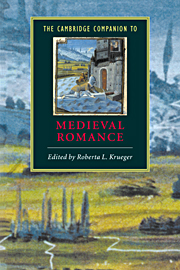Book contents
- Frontmatter
- Introduction
- Part 1 The origins, forms, and contexts of medieval romance
- Part 2 European romance and medieval society
- Part 3 European transformations
- 10 The evolution and legacy of French prose romance
- 11 Medieval German romance
- 12 Chivalry and medieval Italian romance
- 13 Gawain and popular chivalric romance in Britain
- 14 Middle English romance
- 15 Romance at the crossroads
- Editions and translations
- Index
- Series list
11 - Medieval German romance
from Part 3 - European transformations
Published online by Cambridge University Press: 28 May 2006
- Frontmatter
- Introduction
- Part 1 The origins, forms, and contexts of medieval romance
- Part 2 European romance and medieval society
- Part 3 European transformations
- 10 The evolution and legacy of French prose romance
- 11 Medieval German romance
- 12 Chivalry and medieval Italian romance
- 13 Gawain and popular chivalric romance in Britain
- 14 Middle English romance
- 15 Romance at the crossroads
- Editions and translations
- Index
- Series list
Summary
THE FIRST JOURNEYS OF ROMANCE
As a literary tradition, medieval German romance arose in the middle of the twelfth century and in different literary guises retained its popularity until and beyond the fifteenth century. The German tradition is rich and diverse: it encompasses some fifty to eighty texts; it includes verse narrative and, beginning in the middle of the thirteenth century, prose translations as well; it sustains a wide variety of genres, the most important of which are Arthurian romances and love adventure stories; and it makes the transition from manuscript culture to print, that is to say, it continues beyond the Middle Ages into the Early Modern period. Nor is the northern European, Germanic-language romance tradition confined to those regions in northern and central Europe that correspond roughly to the modern nation states of Austria, Germany, and Switzerland, although these regions will be the focus of this essay. There are rich medieval romance traditions in other Germanic languages such as Dutch, Flemish, and Old Norse. For our purposes, this essay embarks upon a selective overview of medieval German romance in order to provide a sense of its richness and diversity.
- Type
- Chapter
- Information
- The Cambridge Companion to Medieval Romance , pp. 183 - 202Publisher: Cambridge University PressPrint publication year: 2000
- 2
- Cited by

